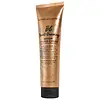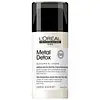What's inside
What's inside
 Key Ingredients
Key Ingredients

 Benefits
Benefits

 Concerns
Concerns

 Ingredients Side-by-side
Ingredients Side-by-side

Water
Skin ConditioningPropanediol
SolventCetearyl Alcohol
EmollientDimethicone
EmollientAleurites Moluccanus Seed Oil
Skin ConditioningHydrogenated Castor Oil/Sebacic Acid Copolymer
EmollientHoney
HumectantYeast Extract
Skin ConditioningOctyldodecyl Citrate Crosspolymer
HumectantStearamidopropyl Dimethylamine
EmulsifyingBehentrimonium Chloride
PreservativeHydroxypropylammonium Gluconate
HumectantHydroxypropylgluconamide
HumectantCaprylyl Glycol
EmollientMethyl Trimethicone
Skin ConditioningEthyl Macadamiate
Skin ConditioningHydrolyzed Wheat Protein Pg-Propyl Silanetriol
Skin ConditioningLactic Acid
BufferingGlycine Soja Oil
EmollientTocopherol
AntioxidantAscorbyl Palmitate
AntioxidantCetyl Hydroxyethylcellulose
Emulsion StabilisingPolyquaternium-4
Acrylates/Dimethicone Copolymer
Skin ConditioningDimethicone PEG-8 Polyacrylate
Panthenol
Skin ConditioningButyl Methoxydibenzoylmethane
UV AbsorberEthylhexyl Methoxycinnamate
UV AbsorberButylene Glycol
HumectantParfum
MaskingLinalool
PerfumingBenzyl Salicylate
PerfumingBenzyl Alcohol
PerfumingLimonene
PerfumingBenzyl Benzoate
AntimicrobialBHT
AntioxidantSodium Hydroxide
BufferingTartaric Acid
BufferingPhenoxyethanol
PreservativePotassium Sorbate
PreservativeSodium Benzoate
MaskingMica
Cosmetic ColorantCI 77891
Cosmetic ColorantCI 15510
Cosmetic ColorantCI 19140
Cosmetic ColorantCaramel
Cosmetic ColorantWater, Propanediol, Cetearyl Alcohol, Dimethicone, Aleurites Moluccanus Seed Oil, Hydrogenated Castor Oil/Sebacic Acid Copolymer, Honey, Yeast Extract, Octyldodecyl Citrate Crosspolymer, Stearamidopropyl Dimethylamine, Behentrimonium Chloride, Hydroxypropylammonium Gluconate, Hydroxypropylgluconamide, Caprylyl Glycol, Methyl Trimethicone, Ethyl Macadamiate, Hydrolyzed Wheat Protein Pg-Propyl Silanetriol, Lactic Acid, Glycine Soja Oil, Tocopherol, Ascorbyl Palmitate, Cetyl Hydroxyethylcellulose, Polyquaternium-4, Acrylates/Dimethicone Copolymer, Dimethicone PEG-8 Polyacrylate, Panthenol, Butyl Methoxydibenzoylmethane, Ethylhexyl Methoxycinnamate, Butylene Glycol, Parfum, Linalool, Benzyl Salicylate, Benzyl Alcohol, Limonene, Benzyl Benzoate, BHT, Sodium Hydroxide, Tartaric Acid, Phenoxyethanol, Potassium Sorbate, Sodium Benzoate, Mica, CI 77891, CI 15510, CI 19140, Caramel
Water
Skin ConditioningButylene Glycol
HumectantAminopropyl Dimethicone
Isododecane
EmollientIsononyl Isononanoate
EmollientGlycine
BufferingPEG-240/Hdi Copolymer Bis-Decyltetradeceth-20 Ether
StabilisingUndecane
EmollientCaprylyl Glycol
EmollientSclerotium Gum
Emulsion StabilisingTridecane
PerfumingTocopherol
AntioxidantEthylhexyl Salicylate
UV AbsorberLimonene
PerfumingSodium Citrate
BufferingCitric Acid
BufferingHexyl Cinnamal
PerfumingLinalool
PerfumingCitral
PerfumingGeraniol
PerfumingCoumarin
PerfumingPotassium Laurate
EmulsifyingPolyquaternium-7
Sodium Benzoate
MaskingHelianthus Annuus Seed Oil
EmollientParfum
MaskingWater, Butylene Glycol, Aminopropyl Dimethicone, Isododecane, Isononyl Isononanoate, Glycine, PEG-240/Hdi Copolymer Bis-Decyltetradeceth-20 Ether, Undecane, Caprylyl Glycol, Sclerotium Gum, Tridecane, Tocopherol, Ethylhexyl Salicylate, Limonene, Sodium Citrate, Citric Acid, Hexyl Cinnamal, Linalool, Citral, Geraniol, Coumarin, Potassium Laurate, Polyquaternium-7, Sodium Benzoate, Helianthus Annuus Seed Oil, Parfum
Ingredients Explained
These ingredients are found in both products.
Ingredients higher up in an ingredient list are typically present in a larger amount.
Butylene Glycol (or BG) is used within cosmetic products for a few different reasons:
Overall, Butylene Glycol is a safe and well-rounded ingredient that works well with other ingredients.
Though this ingredient works well with most skin types, some people with sensitive skin may experience a reaction such as allergic rashes, closed comedones, or itchiness.
Learn more about Butylene GlycolCaprylyl Glycol is a humectant and emollient, meaning it attracts and preserves moisture.
It is a common ingredient in many products, especially those designed to hydrate skin. The primary benefits are retaining moisture, skin softening, and promoting a healthy skin barrier.
Though Caprylyl Glycol is an alcohol derived from fatty acids, it is not the kind that can dry out skin.
This ingredient is also used as a preservative to extend the life of products. It has slight antimicrobial properties.
Learn more about Caprylyl GlycolLimonene is a fragrance that adds scent and taste to a formulation.
It's found in the peel oil of citrus fruits and other plants such as lavender and eucalyptus. The scent of limonene is generally described as "sweet citrus".
Limonene acts as an antioxidant, meaning it helps neutralize free radicals.
When exposed to air, oxidized limonene may sensitize the skin. Because of this, limonene is often avoided by people with sensitive skin.
The term 'fragrance' is not regulated in many countries. In many cases, it is up to the brand to define this term. For instance, many brands choose to label themselves as "fragrance-free" because they are not using synthetic fragrances. However, their products may still contain ingredients such as essential oils that are considered a fragrance.
Learn more about LimoneneLinalool is a fragrance and helps add scent to products. It's derived from common plants such as cinnamon, mint, citrus, and lavender.
Like Limonene, this ingredient oxidizes when exposed to air. Oxidized linalool can cause allergies and skin sensitivity.
This ingredient has a scent that is floral, spicy tropical, and citrus-like.
Learn more about LinaloolParfum is a catch-all term for an ingredient or more that is used to give a scent to products.
Also called "fragrance", this ingredient can be a blend of hundreds of chemicals or plant oils. This means every product with "fragrance" or "parfum" in the ingredients list is a different mixture.
For instance, Habanolide is a proprietary trade name for a specific aroma chemical. When used as a fragrance ingredient in cosmetics, most aroma chemicals fall under the broad labeling category of “FRAGRANCE” or “PARFUM” according to EU and US regulations.
The term 'parfum' or 'fragrance' is not regulated in many countries. In many cases, it is up to the brand to define this term.
For instance, many brands choose to label themselves as "fragrance-free" because they are not using synthetic fragrances. However, their products may still contain ingredients such as essential oils that are considered a fragrance by INCI standards.
One example is Calendula flower extract. Calendula is an essential oil that still imparts a scent or 'fragrance'.
Depending on the blend, the ingredients in the mixture can cause allergies and sensitivities on the skin. Some ingredients that are known EU allergens include linalool and citronellol.
Parfum can also be used to mask or cover an unpleasant scent.
The bottom line is: not all fragrances/parfum/ingredients are created equally. If you are worried about fragrances, we recommend taking a closer look at an ingredient. And of course, we always recommend speaking with a professional.
Learn more about ParfumSodium Benzoate is a preservative. It's used in both cosmetic and food products to inhibit the growth of mold and bacteria. It is typically produced synthetically.
Both the US FDA and EU Health Committee have approved the use of sodium benzoate. In the US, levels of 0.1% (of the total product) are allowed.
Sodium benzoate works as a preservative by inhibiting the growth of bacteria inside of cells. It prevents the cell from fermenting a type of sugar using an enzyme called phosphofructokinase.
It is the salt of benzoic acid. Foods containing sodium benzoate include soda, salad dressings, condiments, fruit juices, wines, and snack foods.
Studies for using ascorbic acid and sodium benzoate in cosmetics are lacking, especially in skincare routines with multiple steps.
We always recommend speaking with a professional, such as a dermatologist, if you have any concerns.
Learn more about Sodium BenzoateTocopherol (also known as Vitamin E) is a common antioxidant used to help protect the skin from free-radicals and strengthen the skin barrier. It's also fat soluble - this means our skin is great at absorbing it.
Vitamin E also helps keep your natural skin lipids healthy. Your lipid skin barrier naturally consists of lipids, ceramides, and fatty acids. Vitamin E offers extra protection for your skin’s lipid barrier, keeping your skin healthy and nourished.
Another benefit is a bit of UV protection. Vitamin E helps reduce the damage caused by UVB rays. (It should not replace your sunscreen). Combining it with Vitamin C can decrease sunburned cells and hyperpigmentation after UV exposure.
You might have noticed Vitamin E + C often paired together. This is because it is great at stabilizing Vitamin C. Using the two together helps increase the effectiveness of both ingredients.
There are often claims that Vitamin E can reduce/prevent scarring, but these claims haven't been confirmed by scientific research.
Learn more about TocopherolWater. It's the most common cosmetic ingredient of all. You'll usually see it at the top of ingredient lists, meaning that it makes up the largest part of the product.
So why is it so popular? Water most often acts as a solvent - this means that it helps dissolve other ingredients into the formulation.
You'll also recognize water as that liquid we all need to stay alive. If you see this, drink a glass of water. Stay hydrated!
Learn more about Water